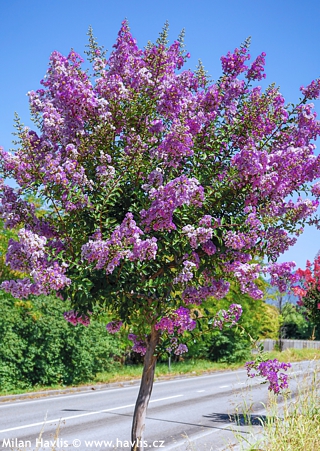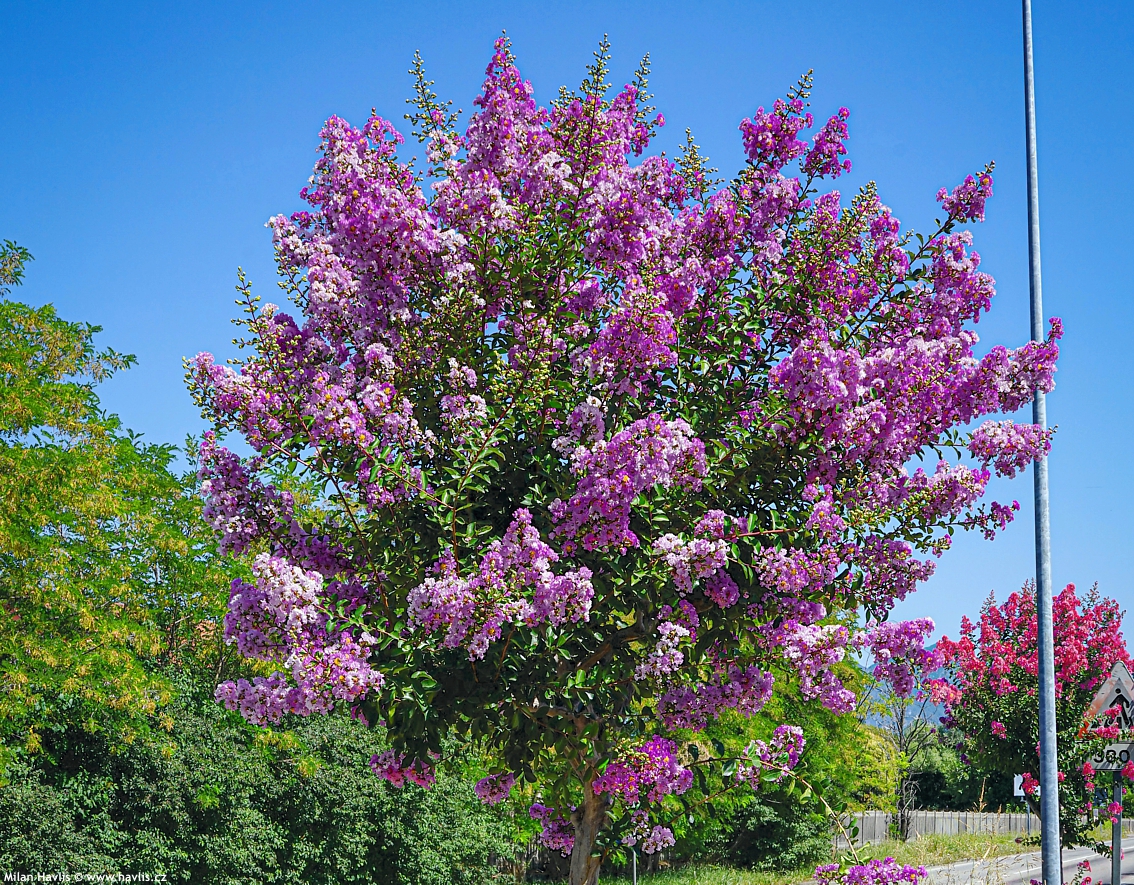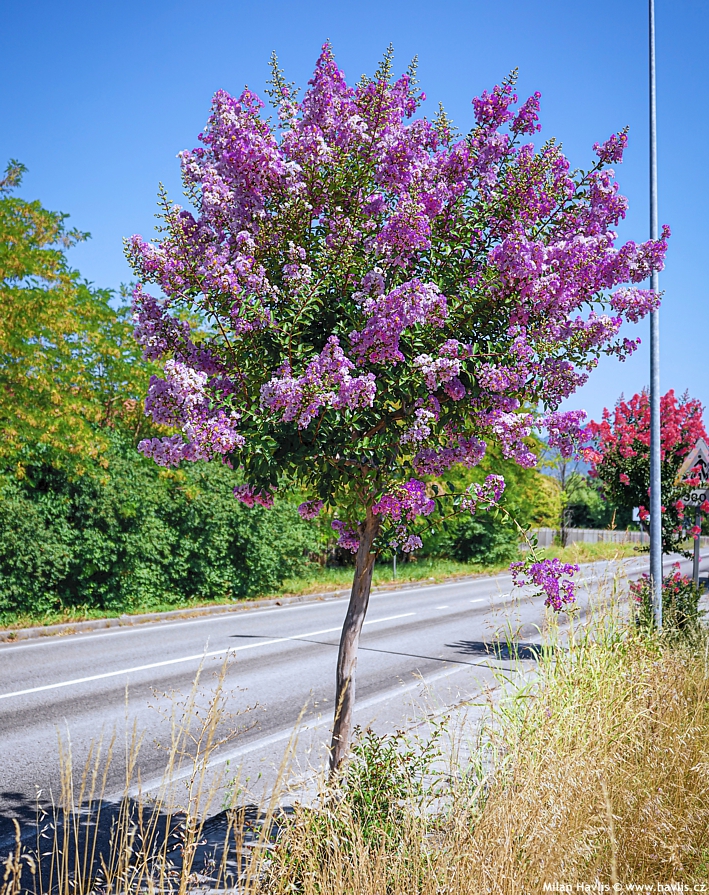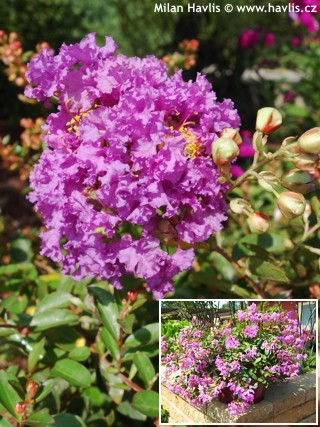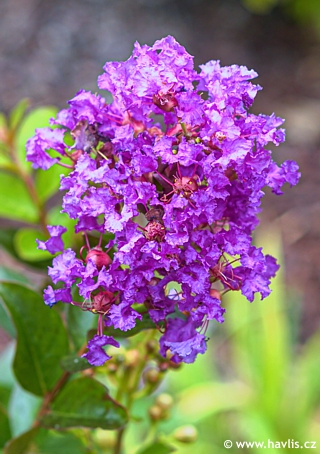Lagerstroemia indica 'POWHATAN' crepe myrtle


Lagerstroemia
Crape myrtle is a flowering shrub or small tree from China. It was first introduced to the USA and the UK in the 18th century. The original plant lagerstroemia indica is too tender and not too pretty so breeders were working on further hybridization and the most attractive varieties available now are believed to be results of crossing with l.speciosa and l.fauriei. Far more important news for us is the fact that among those finished plants were selected others that survived lower temperatures than what was common in the areas of natural habitat so we have a few myrtles that can grow even in our climate. Some were selections, other consequent hybrids.One of the pioneers in breeding hardy crepe myrtles was an American botanist Dr. Donald Egolf from the U.S. National Arboretum in Washington, D.C. Honouring his name, his and subsequent hybrids are sometimes called x egolfii. His unique breeding programme began in 1959 when he used seeds of the l. fauriei species, which three years earlier had been collected by his colleague Dr. John Creech on the Japanese island of Yakushima. Creech noticed the remarkable resistance of the plants there, not only to powdery mildew, but also to the not-so-friendly climate since the bushes and trees grew in very exposed places. Such conditions could not compete with the hot and humid climate of the original species of l. indica.
The name Powhatan refers to a leader of Native Americans whose native name was Wahunsenacawh and who lived at the turn of the 16th and 17th century. He fought the first battles to protect his people and territory after the raids of the British conquerors. He had a daughter, Matoaka, aka Pocahontas. The breeder Dr. Egolf chose Native American names for many of his varieties deliberately as a tribute to the people whose nation was irreparably harmed.
Crepe myrtles naturally form V-shaped shrubs or multi-stemmed trees. You can leave them to their own devices or train them into a spectacular multistems: when your plant reaches a height of around two meters you can start removing lateral branches from the lower parts to shape it into an elegant multi-stemmed tree. Mature trunks produce a beautiful pattern similar to that on planetrees, with several shades of brown, green, and beige. When the trees shed leaves and trunks become bare the display of these coloured trunks of crepe myrtles is usually the best.
Crepe myrtles need little care. They need full sun with zero shade during the day. Grow them in well-drained soil that should be kept moist before the plant is fully established. If cultivated in acidic soil the plant will make fabulous colour play of autumn foliage. Crape myrtle needs heavy mulching in winter and some mulch in summer to retain moisture. Fertilize it in spring to encourage growth (nitrogen-based fertilizers), and in summer to encourage flowering (phosphorus-based fertilizers). Powahatan is above ground (wood) hardy to about -18 °C, and root-hardy to about -24 °C.
Last update: 28-07-2023
Goods are shipped all over Europe. For Russia and U.K. and for further details please read about SHIPPING OPTIONS HERE.
Are you interested in a serious discount for orders NOV-FEB? Check your options here.
THE PRICES INCLUDE VAT of 15%. For quick conversion you can use 1 CZK = approx. 0.04 EUR
- STANDARD QUALITY - Plants of this group are 1st class quality with number of branches and overall density adequate to their size and age, considering they were container grown.
- DE LUXE QUALITY - This label guarantees a luxurious quality of manually selected plants that, compared to their height and age, are exceptionally dense and beautiful.
- EXTRA - These plants are usually mature and bigger specimens with exceptional overall appearance.
- STANDARD (as described in the plant form) means a tree with a trunk of 190-210 cm and a crown at the top, unless specified differently. The commercial size for trees is their girth measured in the height of 1m from ground.
- HOBBY - These plants are of the same quality as our standard-quality plants but younger and therefore cheaper.
- SHRUB - a woody plant with branches growing bushy from the ground level.
- HALF-STANDARD or MINI-STANDARD - a small tree with shorter trunk, its size is usually specified.
- FEATHERED - These are trees with branches growing already from the base of the trunk and up along the stem.
- GRASSES and PERENNIALS - Sizes given usually read the diameter of the pot or the clump, as specified.












